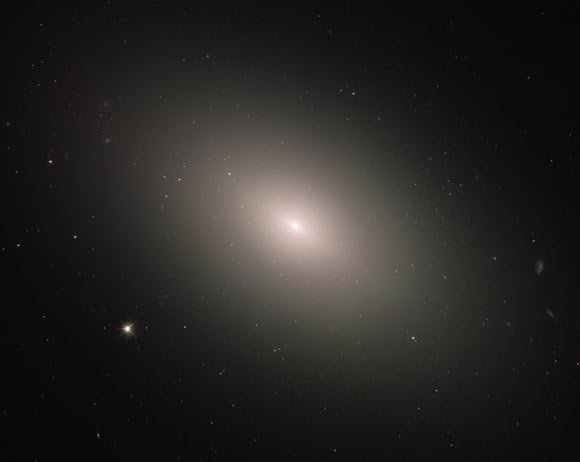The NASA/ESA Hubble Space Telescope has produced this beautiful image of an elliptical galaxy called Messier 59.

This Hubble image shows the elliptical galaxy Messier 59. This image is a composite of separate exposures acquired by Hubble’s Wide Field and Planetary Camera 2 (WFPC2) and Advanced Camera for Surveys (ACS). Four filters were used to sample various wavelengths. The color results from assigning different colors to each monochromatic image associated with an individual filter. Image credit: NASA / ESA / Hubble / P. Cote.
Messier 59, also known as M59 or NGC 4621, lies some 50 million light-years away in the equatorial constellation Virgo.
German astronomer Johann Gottfried Koehler discovered this galaxy and the nearby Messier 60 in the spring of 1779 when observing Comet Bode.
While observing that same comet, French astronomer Charles Messier observed and added Messier 59, Messier 60 and the neighboring Messier 58 to his famous catalogue of deep-sky objects.
Modern observations show that Messier 59 is an elliptical galaxy, one of the three main kinds of galaxies along with spirals and irregulars.
Ellipticals tend to be the most evolved of the trio, full of old, red stars and exhibiting little or no new star formation.
Messier 59, however, bucks this trend somewhat; the galaxy does show signs of star formation, with some newborn stars residing within a disk near the core.
A supermassive black hole with the mass of 270 million solar masses lies in the heart of Messier 59.
The galaxy also hosts around 2,200 globular clusters, an exceptionally high number of such clusters.
The central region of the galaxy, the inner 200 light-years, rotates in the opposite direction than the rest of the galaxy and is the smallest region in a galaxy known to exhibit this behavior.
Messier 59 is one of the largest elliptical galaxies in the Virgo Cluster, a group of about 1,300 — and possibly up to 2,000 — galaxies that form the heart of the Virgo Supercluster.
However, it is still considerably less massive, and at a magnitude of 9.8, less luminous than other elliptical galaxies in the cluster.







